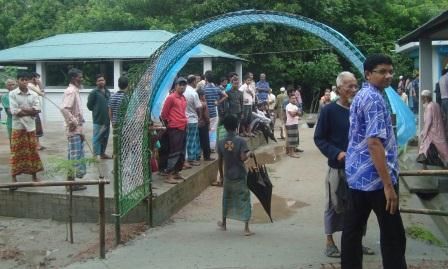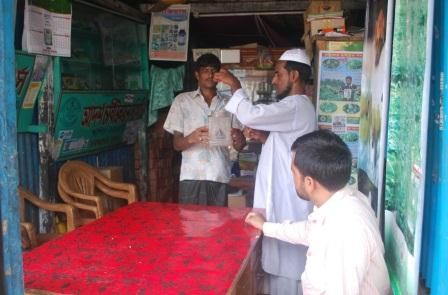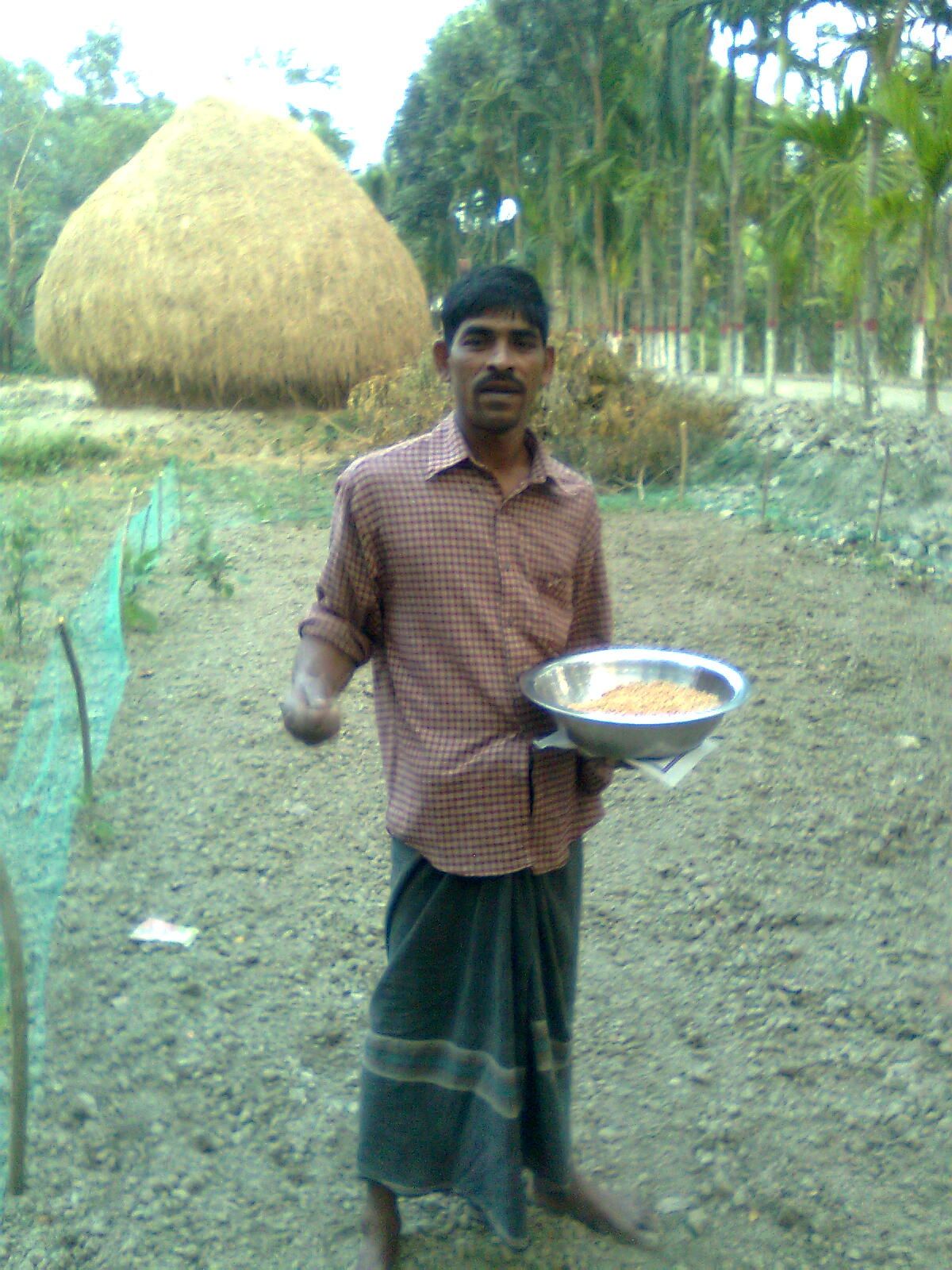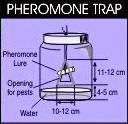Adopting green technologies in Charland regions of Bangladesh
 | ||
Food security is critical for human welfare and economic growth, and is a concern throughout Bangladesh. About 70 per cent of the people who live in the coastal Charland areas depend on agriculture for their livelihoods, primarily by raising staple food crops and a few livestock on farms that are under 2 hectares. By using only modest inputs and better agronomic practices, many of these farms have the potential to produce three to four times as much as they currently produce, which translates into a marketable surplus. IFAD, in collaboration with other partners, is promoting organic agricultural practices to increase farmers’ yields and protect the environment.
With crop yields of less than 1 ton per hectare, many Bangladeshi farmers barely produce enough food to feed their family, let alone generate surplus with which to purchase yield-enhancing inputs. Low farm productivity in the southern Charland areas has many causes, including use of traditional crop varieties, increasingly depleted soils, shrinking plots of land, scarce and unreliable water supply, crop losses from pests and diseases, inequitable land distribution patterns, inefficient and unfair markets, and poor agricultural and transportation infrastructures.
Numerous initiatives aimed at addressing one or more of these problems have been launched in this area, but no desired result was achieved. In 2006 the Local Government Engineering Department (LGED) undertook a combined approach to improve rural infrastructure, through the Market Infrastructure Development Project in Charland Regions (2006-2013) funded by IFAD. Among the project’s many activities, green technologies figured prominently, in particular the adoption of organic agro-farming practices.
Ensuring access to microfinance
As a part of the project, two NGOs mobilized 3,000 groups comprising 70,000 members to provide them with technical and income-generation training and supporting microcredit from Padakhep Manabik Unnayan Kendra (PMUK) and PRISM. The NGOs, including IDE-B (International Development Enterprises – Bangladesh), provided technical training and assistance in micro-enterprise development especially in the cereal, pulse and oil seeds, horticulture, small livestock and fishery sub-sectors.
Based on the training and improved access to microcredit, the Bangladesh Agricultural Research Institute (BARI) introduced new agricultural seeds in Char island. As a result of this effort, the total cultivation area of soybean, pulses and different kinds of vegetable and horticulture products in Charland areas increased from 4,000 hectares in 2009 to 16,000 hectares in 2011. Production increased from 4,800 tons in 2009 tons to 32,000 tons in 2011.
Biofertilizers
 | ||
One of the strategies used by the project safeguard the health of the soil and the quality of crop products is using biofertilizers. Biofertilizers are natural products which have involve microorganisms that promote nutrient acquisition of the plant. one such microorganism is nitrogen: nitrogen fixation by rhizobia improves phosphorous nutrition.
The project aims to improve and disseminate biofertilizer technology to increase the yields of grain legumes and other crops which are important sources of food for humans and animals in the project area, and to enhance environmentally friendly and sustainable farming practices by reducing excessive amounts of chemical fertilizer application. For this purpose, IDE-B identified the most effective microorganisms for each crop.
As a part of the process, IDE-B organized training and knowledge dissemination with 50,000 farmers from the project area. At the same time, extension support was provided to the farmers to encourage them to use biofertilizer and reduce their dependency on chemical fertilizer.
| What is biofertilizer? With the introduction of green revolution technologies, modern agriculture is becoming more and more dependent upon the steady supply of synthetic inputs (mainly fertilizers), which are products of fossil fuel (coal + petroleum). Adverse effects are being noticed due to the excessive and imbalanced use of these synthetic inputs. This situation has led to the identification of harmless inputs like biofertilizers. Biofertilizers are ready-to-use live formulates of beneficial microorganisms. When applied to seeds, roots or soil, they mobilize the availability of nutrients by their biological activity, and help build up the micro-flora and in turn the health of the soil. International Crops Research Institute for the Semi-Arid Tropics (ICRISAT) | ||
The project is very proud that almost 100 per cent of the 50,000 farmers adopted this improved technology by using biofertilizer (inoculums) in producing soybean, mungbean and groundnut over the last three years of the project. This technology is gaining popularity among the farmers in the project area day by day.
According to Mr Md. Faroq, president of a farmer association who was interviewed by the project, , biofertlizer has many advantages such as:
- reduced production cost
- enhanced soil health
- increased yield per hectare
Mr Faroq reported that his production increased 2.5 kg per decimal (about 0.004 hectares) and his production costs decreased by BDT2.5 (USD 0.03) per decimal. Other farmers reported that from the cultivation of soybean their income has increased from BDT127 (USD 1.5) to BDT 227 (USD 2.7) per decimal.
Technology adopted by farmers, government officials, researchers and civil society representatives were expected to foster greater collaboration between stakeholders and encourage the spread of this innovation. During an interview with the Daily Sun, a local newspaper, a sample of 50 farmers shared how new technology benefited them through reducing their dependency on chemical fertilizer. and that about 50,000 farmers have adopted this technology on 22,302 acres of land in the project area.
Composting
 | ||
Due to the growing and alarming trend of increased nitrogen emissions because of the use of fertilizer, the Department of Agricultural Extension (DAE), IFAD’s important partner in Bangladesh, introduced in the project a series of training and awareness programmes about using organic fertilizers. About 74,000 farmers were trained over the first three years of the project. The rationale behind this effort was to improve both human well-being and the environment. To date, 93 per cent of the farmers have acquired knowledge about using compost (cow dung) as organic manure on the soil.
The project found that these farmers perceived the composting and green manure positively. They are now aware that compost helps improve soil health, increases water-holding capacity, helps uptake plant nutrients, and increases organic matter in soil. Use of compost is highly prevalent in the study area. About 87 per cent of the farmers themselves produce compost. About 90 per cent use compost in their own land and 73 per cent have told others to use compost as organic fertilizer.
Green manure
 | ||
Smallholder farming in many parts of southern project areas is mainly constrained by declining soil fertility. Recent studies by IDE-B in the project area have identified soil fertility decline as one of the most important biophysical constraint to agricultural productivity. The use of inorganic fertilizers to alleviate the problem of low soil fertility is limited by high costs and erratic availability of fertilizer in the char areas. Even the few farmers who use inorganic fertilizers cannot afford them.
Under such conditions, one of the alternatives is to use inorganic fertilizers in combination with other sources of plant materials. Integration of green manure legume (Arohor, Dhaincha and Khesari) into farming systems can be a cheaper alternative for alleviating low soil fertility and erosion problems.
DAE and IDE-B had been recommending the adoption of integrated legumes into farming systems of the project area. Along with using compost manure, farmers are now demonstrating the benefits of three crops (Arohor, Dhaincha and Khesari) as green manure. They are now working in harmony with local ecosystems, using natural processes and a mixture of new and traditional technology – while increasing production and income.
Green pest control
Project partners believed that the project area needed to adopt a total integrated pest management system. The insecticide-based system had failed to control many pests, which were becoming resistant to almost all chemical pesticides. The frequency of spraying was gradually increasing while their efficacy was gradually decreasing. In fact, at one time they had to spray only once in a week; this soon became at least once every day. Enter the sex pheromone trap.
A sex pheromone trap is an indigenous technology now widely being used in the project areas. “We call it the ‘magic trap’ because it magically traps fruit flies,” explained Mr Nazrul, an upazila (sub-district) agriculture officer, referring to a recycled plastic bottle containing water, a small amount of pesticide, and a capsule of cuelure. Cuelure is a chemical compound that mimics the odour of female melon fly sex pheromones, which are powerful chemical attractants that female insects emit. The males detect the chemicals, which helps them locate unfertilized females for mating. When the trap is placed in a field of melons, it works wonders, Insects flock to the bottle and drown.
The magic traps are so popular among farmers throughout Bangladesh that demand has increased quickly. Pheromone traps are being used by 55,000 farmers in the project area as a great pest control tool for monitoring and controlling insect infestations. Since the use of the traps, farmers have been reporting good yields from their cultivated products, with minimum cost for the pesticide.
Nazrul said the farmers benefited immensely by using a combination of sex pheromones and beneficial insects when they could no longer control harmful pests, even after spraying cocktail insecticides. Damage to production was 40 to 50 per cent even after spraying cocktail insecticides. But after using sex pheromones and beneficial insects, the rate of damage diminished to 10 per cent.
“We had to spend about BDT 15,000 (USD 187) for chemical pesticides only to produce korela (bitter gourd) on 1 hectare of land. Now, after using sex pheromones and beneficial insects, we spend only BDT 4,000 (USD 50) for the same size of land,” Nazrul pointed out.
To promote non-harmful agri-practices for the well-being of human beings and earth, the project also provides cost sharing, technical assistance and extension education. Practices that the project has approved for cost sharing usually yield long-term benefits and are practices that farmers would not, or could not, undertake without financial and technical assistance. The project currently has activities that provide cost sharing and other funding to farmers who adopt practices that improve or enhance soil quality.
Md. Khalilur Rahman, Project Coordinator, and Md. Shahjahan Miah, Monitoring and Evaluation Specialist, Market Infrastructure Development Project in Charland Regions
Useful links
'庫間 > 해외자료' 카테고리의 다른 글
| 아르헨티나 법원은 제초제의 사용에 주목한다 (0) | 2012.08.07 |
|---|---|
| 라오스에서 유기농 채소 생산을 장려 (0) | 2012.08.07 |
| 간수성에서 물 절약 기술로 수확량을 2배로 (0) | 2012.08.07 |
| 세계는 식량이 아니라 물이 부족하다 (0) | 2012.08.07 |
| 기후변화로 인해 유기농법이 적합해 보인다 (0) | 2012.08.07 |
